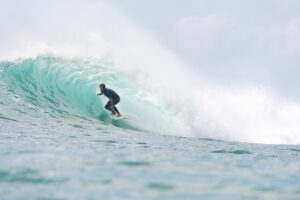Learn to surf in 10 minutes
Welcome back to “How to Surf”! This article is for those who have always wanted to learn to surf. Let’s keep it simple and direct, giving you the information you need to catch waves and be successful in the surfing experience, from standing on the board to riding the waves. So let’s get started!
1. Choose A Safe Location For Beginners
It is important to select a suitable place to surf when you are a beginner. Actually, you don’t need big waves to learn, quite the opposite. Small waves are ideal for beginners. Waves for beginners barely reach the ankles or knees. Although they are small, they are very fun and will allow you to practice the technique of catching the waves. Also, make sure you have a companion in the water, someone who can keep an eye on you while you surf.
2. Equip Yourself Correctly
Surf equipment can be complicated, but for beginners it is quite simple. We recommend using surfboards with a lot of volume, such as the “fishes” or the “high-volume” type. These boards will allow you to progress more easily in your technique and make turns more easily. However, if you are an absolute beginner and just want to get out on the water and catch waves without buying a board that will last you several years, we recommend a long foam board or longboard. These boards are very floaty and will make it easier for you to catch waves, as long as you position yourself correctly on the board.
3. Use An Invention (Leg Strap)
It is important to use a leg strap, also known as a “leash”, “leg rope” or “leash”. This strap attaches to the back of the board and sits around your ankle. The leg rope allows you to maintain your connection to the board, especially in case you fall. Be sure to securely fasten the strap to your ankle before entering the water.
4. Apply Wax To Your Surfboard
Before you get in the water, be sure to apply wax to your surfboard. The wax provides a tacky surface so you can stay stable on the board. You can find surf wax at any specialty store.
5. Learn The Technique Of Catching Waves And Standing Up
Once you’ve selected a safe location, rigged up correctly, and waxed your board, it’s time to hit the waves. But first, you must learn the technique to position yourself correctly on the board and catch the waves. It is important to find the sweet spot on the table , which can vary depending on the model and the person. Once you feel comfortable with your balance on the board, start paddling out into the waves.
To catch a wave, you must position yourself properly on the board. If you get too far forward, the wave will overtake you; if you go too far back, the board will sink. Find a middle ground where you can balance and have control.
When looking for a wave, pay attention to those that appear foamy and soft . These waves are great for beginners as they are easy to catch and forgiving. Once you’ve mastered lapping off the foam, you can progress and start catching waves before they break for a true surfing experience.
Before attempting to stand up, practice catching waves while lying on the board . This step is one of the most difficult for beginners, so it’s important to practice it. Follow the procedure below: walk the board into the water until the water is waist deep; then, turn the board over so that the nose is facing the shoreline. If you’re not sure which end is the nose and which is the tail, remember that the leg strap clips onto the tail. Once you’re in position, paddle forward with long, powerful strokes, keeping your hands on the edge of the board and kicking out with your feet. Do not stop rowing until the wave lifts you up and propels you. At this stage, you should only be lying on the board to familiarize yourself with the sensation of being carried by a wave.
After practicing taking off on the foam, it’s time to learn how to stand up. You can practice this in the sand , drawing the outline of a board and marking a line down the center to guide the position of your feet. Remember that when you stand up, you must lift your chest to create space for your legs to pass through. Then, bring your front leg forward and place your back leg behind it. The distance between your feet should be approximately shoulder width apart. Once you’re standing on the board, you can release your hands and maintain a slightly forward-leaning stance. Remember that the direction you face with your leading arm is where you will go. This technique will be maintained throughout your surfing experience.
We hope this article helps you take your first steps in the world of surfing. Remember that constant practice and patience are key to improving. Enjoy the waves and have fun learning to surf!





